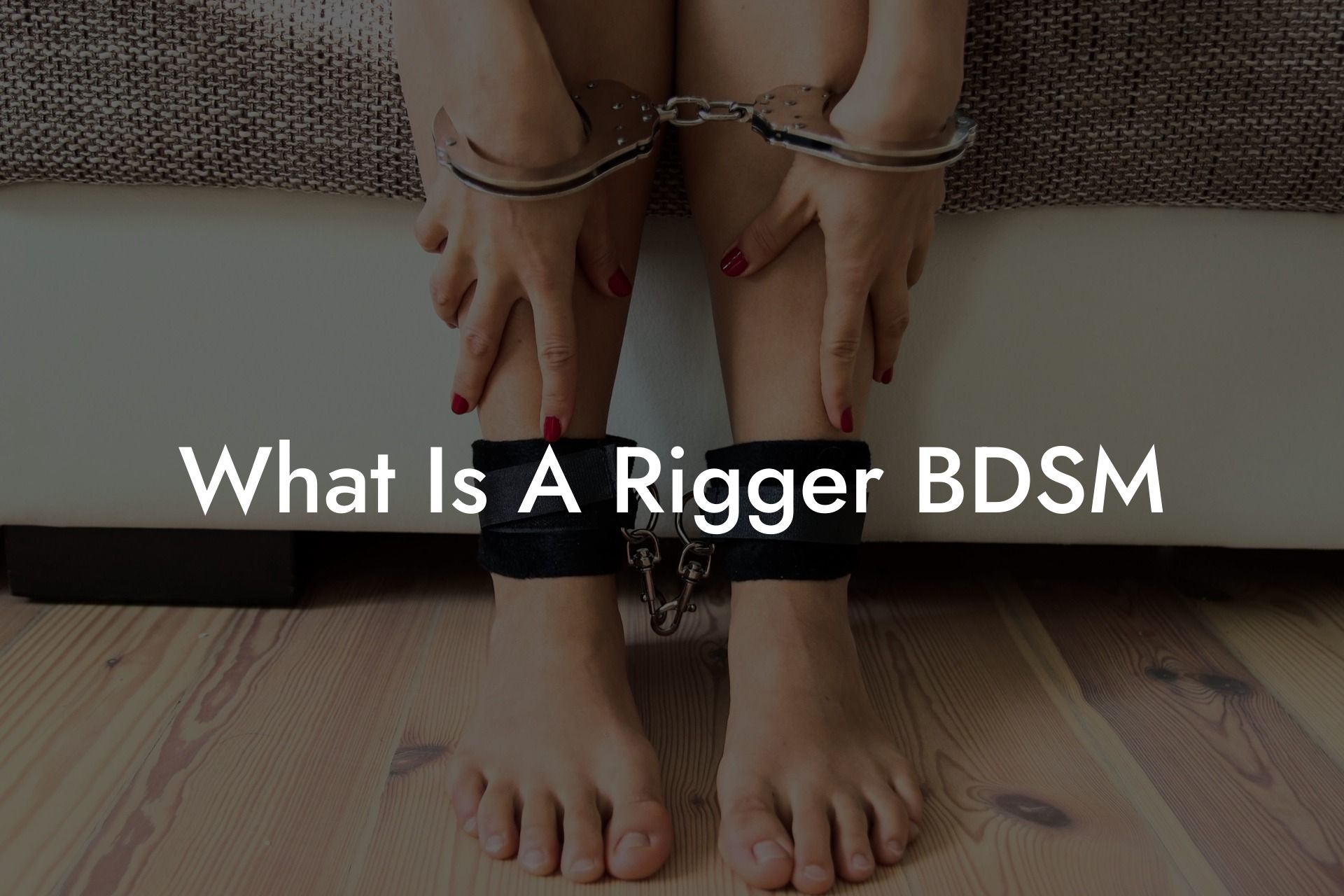What Is A Rigger BDSM

Imagine entering a world where every knot is a work of art, every twist of rope a carefully orchestrated act of trust and creativity. In the realm of BDSM, a rigger is the skilled artisan behind rope bondage, a master of knots and techniques who transforms simple rope into a medium for both aesthetic expression and consensual power exchange. Whether you’re new to rope bondage or a seasoned practitioner looking to refine your craft, understanding what a rigger is in BDSM is essential to appreciating the depth, beauty, and safety inherent in this dynamic art form.
Quick Links to Useful Sections
- Understanding the Role of a Rigger in BDSM
- Defining the Rigger
- The Historical and Cultural Context of Rigging
- From Shibari to Modern Rope Bondage
- The Core Responsibilities of a Rigger
- Technical Mastery and Safety
- Artistic Expression and Creativity
- Techniques and Tools in Rigging
- Fundamental Knots and Tying Techniques
- Specialized Equipment and Materials
- Negotiation and Consent in Rigging
- Pre-Scene Discussions
- Communication During the Scene
- Safety Measures and Aftercare in Rigging
- Ensuring Physical Safety
- Comprehensive Aftercare
- The Benefits of Rigging in BDSM
- Enhanced Sensory Experience
- Artistic Expression and Aesthetic Beauty
- Deepening Trust and Intimacy
- Real-Life Experiences and Inspirations
- Case Study: Emma’s Journey with Shibari
- Case Study: Ryan’s Artistic Expression
- Expert Insights: Guidance from the BDSM Community
- Words of Wisdom from Experienced Riggers
- FAQ: Your “What Is A Rigger in BDSM” Questions Answered
Understanding the Role of a Rigger in BDSM
Defining the Rigger
In the context of BDSM, a rigger is someone who specializes in tying and restraining a partner using ropes or other restraints. This role goes far beyond simply binding limbs, it involves a fusion of technical skill, artistic vision, and an acute awareness of safety. A rigger’s work is about creating ties that are both visually stunning and physically secure, ensuring that every bondage session is a harmonious blend of discipline and beauty.
The art of rigging, often influenced by the Japanese tradition of shibari, emphasizes not only the functional aspect of restraint but also its expressive potential. Rigging can transform the body into a living sculpture, highlighting curves, lines, and movement, while simultaneously facilitating a deep power exchange between the participants.
The Historical and Cultural Context of Rigging
From Shibari to Modern Rope Bondage
The practice of rigging has a rich history, with its roots in the traditional Japanese art of shibari, which originally served as a method of restraint but evolved into an art form that emphasizes beauty and the intricacies of rope work. Over time, shibari spread beyond Japan, influencing modern BDSM and becoming a central element in many bondage scenes.
Today, rigger techniques are celebrated for their artistic and erotic qualities. Modern riggers draw on traditional methods while also innovating new techniques that cater to the evolving needs and safety standards of the BDSM community. This evolution reflects a broader cultural shift toward embracing alternative expressions of sexuality and art.
The Core Responsibilities of a Rigger
Technical Mastery and Safety
At the heart of being a rigger is the technical mastery of various knots and ties. A rigger must have a comprehensive understanding of:
- Fundamental Knots: Techniques such as the single column tie, double column tie, and various hitch knots form the foundation of effective rigging.
- Pressure and Tension: Knowing how much tension to apply is critical to ensure the ties are secure without restricting blood flow or causing injury.
- Anatomical Knowledge: A deep understanding of human anatomy is essential to avoid nerve damage, maintain circulation, and ensure that the restraints are both safe and comfortable.
Safety is paramount in rigging. A skilled rigger is always vigilant, continuously checking in with their partner to ensure that every tie is secure yet comfortable. This attention to detail transforms potentially risky play into a secure, transformative experience.
Artistic Expression and Creativity
Beyond technical skill, a rigger is an artist. The way ropes are arranged and displayed can transform the body into a canvas of intricate designs and patterns. This artistic expression is not only visually captivating but also plays a significant role in heightening the emotional and psychological dimensions of the scene.
Many riggers take pride in their unique style, blending traditional shibari techniques with modern twists to create designs that are both erotic and expressive. The beauty of a well-executed tie lies in its ability to evoke emotion, create tension, and amplify the power dynamics between the participants.
Looking for the best BDSM & Kink OnlyFans content creators? Check out these UNBELIEVABLE OnlyFans Creators:
-
-
-
- Best Slutty Asian Cosplay OnlyFans → 🥵 Shadow Kitsune → View Pictures & Videos
- Best Solo & Dildo Play OnlyFans Creator → 🌹 Lexy , Your Fifty Shades of Fantasy 🌹 → View Pictures & Videos
- Best Filthy Teen Brat & Girlfriend Experience OnlyFans Creator → 💋 Alexa – Your Shy & Wild Girlfriend 💋 → View Pictures & Videos
- Best Slutty Submissive British Blonde OnlyFans Creator → Sofia 🧚 → View Pictures & Videos
- Best Anal, Sexting & Dick Rating OnlyFans Creator → Sofia💕 → View Pictures & Videos
- Best Hot Asian & Latina Mixed OnlyFans Creator → 🍑 Miso Lexii - Half Latina / Half Asian 👅 → View Pictures & Videos
-
-
Techniques and Tools in Rigging
Fundamental Knots and Tying Techniques
Mastery of basic knots is the first step in becoming a skilled rigger. Essential techniques include:
- Single Column Tie: Ideal for binding a single limb, this knot is simple yet versatile, forming the basis for more complex ties.
- Double Column Tie: Used to bind two limbs together, this knot ensures even pressure distribution and a secure hold.
- Advanced Patterns: Techniques such as decorative harnesses or full-body ties build on these fundamentals to create intricate, visually stunning designs.
Each knot is a building block, and mastering these basics allows a rigger to progress to more advanced and artistic ties.
Specialized Equipment and Materials
While traditional rope is the most common material used in rigging, the choice of equipment can vary based on the desired aesthetic and functionality. Options include:
- Natural vs. Synthetic Rope: Natural ropes, like jute or hemp, are favored for their tactile feel and aesthetic appeal, while synthetic ropes, like nylon or polyester, may offer more durability and easier maintenance.
- Quick-Release Tools: Safety scissors and other quick-release devices are essential to ensure that ties can be swiftly undone in case of an emergency.
- Additional Restraints: Sometimes, other materials like cuffs or specialized bondage gear are incorporated to complement the rope work and enhance the overall design.
The careful selection of materials and tools is integral to achieving both the desired visual effect and the necessary safety standards.
Negotiation and Consent in Rigging
Pre-Scene Discussions
Just as with any other aspect of BDSM, the use of intricate rope work begins with thorough negotiation. Before a scene, the rigger and their partner must discuss:
- Desired Outcome: What are the goals of the scene? Is it about aesthetic display, intense physical sensation, or deep emotional connection?
- Physical Boundaries: Which parts of the body are safe to tie, and which are off-limits? This discussion is crucial to avoid injury and ensure comfort.
- Safe Words and Signals: Establish clear safe words or non-verbal cues that can be used to immediately pause or stop the scene if necessary.
- Aftercare Requirements: Outline the aftercare process, including physical and emotional support, to ensure a smooth transition after the scene ends.
Clear, explicit negotiation is the cornerstone of any successful rigging session, ensuring that all participants feel secure and respected throughout the experience.
Communication During the Scene
Once the ropes are tied and the scene is underway, continuous communication is key. A skilled rigger remains alert to the subtle cues from their partner, monitoring for signs of discomfort or distress, and adjusts the tension, position, or intensity as needed. Regular check-ins, both verbal and non-verbal, help maintain the balance between artistic expression and physical safety.
This real-time feedback ensures that the experience remains within the negotiated boundaries, transforming what could be a risky endeavor into a controlled, exhilarating exploration of trust and creativity.
Safety Measures and Aftercare in Rigging
Ensuring Physical Safety
Safety is paramount in rigging, given the inherent risks involved in tying and restraining a partner. Essential safety measures include:
- Proper Knot Technique: Ensuring that knots are tied correctly to prevent accidental tightening or slipping.
- Regular Checks: Continuously monitoring the tied areas for signs of restricted circulation, numbness, or discomfort.
- Quick-Release Mechanisms: Having safety scissors or other quick-release tools readily available to free the submissive immediately if needed.
- Comfort and Fit: Making sure that the rope or restraints are not too tight, and that they allow for necessary movement and blood flow.
These precautions help ensure that the experience remains safe and enjoyable, minimizing the risk of injury.
Comprehensive Aftercare
Aftercare is a critical component of any BDSM scene, particularly in intense rigging sessions. Aftercare involves:
- Physical Reassurance: Offering water, warm blankets, and gentle massages to alleviate any physical tension or discomfort.
- Emotional Debriefing: Engaging in open dialogue to discuss the scene, share feelings, and reaffirm trust between partners.
- Rest and Recovery: Allowing time for both partners to rest and process the intense physical and emotional sensations experienced during the scene.
Effective aftercare reinforces the trust built during the scene and helps integrate the intense experience into everyday life.
The Benefits of Rigging in BDSM
Enhanced Sensory Experience
Rigging can heighten physical sensation by applying pressure, restricting movement, and creating intricate patterns of tension across the body. For many, the controlled stimulation of rope bondage can lead to powerful, orgasmic experiences that transcend traditional forms of sexual play.
The interplay between physical restraint and psychological anticipation creates a unique sensory landscape that deepens arousal and enhances overall pleasure.
Artistic Expression and Aesthetic Beauty
Beyond its functional purpose, rigging is celebrated as a form of artistic expression. The intricate patterns and designs created by skilled riggers transform the body into a living canvas, showcasing the beauty of both the human form and the art of bondage. This aesthetic aspect adds an emotional and visual dimension to the scene, making each tie a unique, expressive statement.
Deepening Trust and Intimacy
The process of rigging requires an immense amount of trust between the rigger and the submissive. This shared vulnerability fosters a deep emotional bond that can extend beyond the play session. As the submissive allows themselves to be artistically restrained, they experience a profound sense of surrender and connection that reinforces the overall power exchange dynamic.
Looking for the best BDSM & Kink OnlyFans content creators? Check out these UNBELIEVABLE OnlyFans Creators:
-
-
-
- Best Slutty Asian Cosplay OnlyFans → 🥵 Shadow Kitsune → View Pictures & Videos
- Best Solo & Dildo Play OnlyFans Creator → 🌹 Lexy , Your Fifty Shades of Fantasy 🌹 → View Pictures & Videos
- Best Filthy Teen Brat & Girlfriend Experience OnlyFans Creator → 💋 Alexa – Your Shy & Wild Girlfriend 💋 → View Pictures & Videos
- Best Slutty Submissive British Blonde OnlyFans Creator → Sofia 🧚 → View Pictures & Videos
- Best Anal, Sexting & Dick Rating OnlyFans Creator → Sofia💕 → View Pictures & Videos
- Best Hot Asian & Latina Mixed OnlyFans Creator → 🍑 Miso Lexii - Half Latina / Half Asian 👅 → View Pictures & Videos
-
-
This trust, once established, often enhances the intimacy of the relationship, making future scenes more fulfilling and meaningful.
Real-Life Experiences and Inspirations
Case Study: Emma’s Journey with Shibari
Emma, a submissive who has explored various forms of rope bondage, recounts her transformative experience with a skilled rigger who introduced her to the art of shibari. Through carefully negotiated sessions, Emma learned to appreciate the beauty and intensity of well-executed ties. The rigger’s attention to detail, combined with clear communication and attentive aftercare, allowed Emma to experience both physical pleasure and deep emotional release. Her journey highlights how rigging can be a profoundly transformative experience, opening new avenues of sensory exploration and trust.
Case Study: Ryan’s Artistic Expression
Ryan, an experienced rigger and Dominant, shares how his passion for rope artistry has evolved over the years. By combining traditional shibari techniques with modern innovations, he creates scenes that are as visually captivating as they are erotically charged. Ryan’s commitment to safety, continuous negotiation, and thorough aftercare has earned him a reputation as a true artist in the BDSM community. His work not only enhances the physical pleasure of his submissive partners but also builds lasting bonds based on mutual trust and creative expression.
Expert Insights: Guidance from the BDSM Community
Words of Wisdom from Experienced Riggers
Veteran rigger Marcus Steele advises, “Rigging is an art that marries technical precision with creative expression. The trust between a rigger and their partner is paramount; when that trust is honored through clear communication and meticulous technique, the experience becomes truly transformative.”
BDSM educator Fiona Rivera adds, “The beauty of rigging lies in its ability to heighten physical sensations while deepening emotional connection. By negotiating every detail, from knot choice to aftercare, a skilled rigger creates a safe, empowering environment that allows both partners to explore their limits and discover new pleasures.”
FAQ: Your “What Is A Rigger in BDSM” Questions Answered
1. What is a rigger in BDSM?
A rigger in BDSM is a person who specializes in tying and restraining a partner using ropes or other restraints. They combine technical skill with artistic creativity to create beautiful and safe bondage scenes.
2. What skills does a rigger need?
A rigger needs to master various knots (such as the single and double column ties), understand human anatomy to ensure safety, and have strong communication skills to negotiate boundaries and check in with their partner.
3. How does rigging enhance a BDSM scene?
Rigging enhances a scene by adding a layer of sensory stimulation, visual artistry, and emotional depth. The intricate patterns and controlled restraint can amplify arousal and deepen trust between partners.
4. What materials are commonly used in rigging?
Riggers typically use natural ropes like jute or hemp for their aesthetic and tactile qualities, although synthetic ropes such as nylon or polyester may also be used for durability and ease of maintenance.
5. How do riggers ensure safety during a scene?
Safety is ensured through thorough pre-scene negotiations, proper knot techniques, continuous monitoring of the submissive’s physical responses, and having quick-release tools available in case the tie needs to be undone quickly.
6. What is shibari?
Shibari is the Japanese art of rope bondage, known for its intricate, decorative ties that are both functional and aesthetically beautiful. It is a major influence on modern rigging techniques.
7. Can rigging be used in both casual scenes and long-term dynamics?
Yes, rigging can be incorporated into one-off scenes as well as ongoing BDSM relationships, depending on the preferences and negotiated dynamics of the partners.
8. Is there any formal training required to be a rigger?
Formal training isn’t mandatory, but many riggers learn through workshops, online tutorials, mentorship, and extensive practice to hone their skills and ensure safety.
9. What are the psychological benefits of rigging?
Rigging can foster a deep sense of trust and intimacy between partners. For the submissive, being artistically restrained can be a transformative experience that enhances self-awareness and emotional release.
10. Where can I learn more about rigging in BDSM?
Reputable resources include books like "SM 101: A Realistic Introduction," online communities such as FetLife and Reddit’s r/BDSM, podcasts like "Kink Academy," and workshops or seminars dedicated to rope bondage and shibari.
Resources and Community Support: Your Next Steps in Exploring Rigger BDSM
- FetLife: Connect with experienced riggers and join discussions about rope bondage, shibari, and safety practices within the BDSM community.
- Reddit: Participate in subreddits like r/BDSM for firsthand experiences and tips on improving your rigging techniques.
- BDSM Literature: Explore foundational texts such as "SM 101: A Realistic Introduction" to build your knowledge about safe, consensual rigging practices.
- Podcasts and Videos: Listen to "Kink Academy" and watch online tutorials for expert guidance on mastering the art of rigging.
- Workshops and Local Events: Attend classes and seminars to refine your skills, share experiences, and network with like-minded individuals.
Embracing the art of rigging in BDSM is a journey that blends technical skill with creative expression and trust. With clear communication, rigorous safety practices, and a supportive community, you can transform simple rope into a medium for profound connection, intense pleasure, and artistic expression.
Looking for the best BDSM & Kink OnlyFans content creators? Check out these UNBELIEVABLE OnlyFans Creators:
-
-
-
- Best Slutty Asian Cosplay OnlyFans → 🥵 Shadow Kitsune → View Pictures & Videos
- Best Solo & Dildo Play OnlyFans Creator → 🌹 Lexy , Your Fifty Shades of Fantasy 🌹 → View Pictures & Videos
- Best Filthy Teen Brat & Girlfriend Experience OnlyFans Creator → 💋 Alexa – Your Shy & Wild Girlfriend 💋 → View Pictures & Videos
- Best Slutty Submissive British Blonde OnlyFans Creator → Sofia 🧚 → View Pictures & Videos
- Best Anal, Sexting & Dick Rating OnlyFans Creator → Sofia💕 → View Pictures & Videos
- Best Hot Asian & Latina Mixed OnlyFans Creator → 🍑 Miso Lexii - Half Latina / Half Asian 👅 → View Pictures & Videos
-
-

 Fuck Each Other Not The Planet Unisex
Fuck Each Other Not The Planet Unisex Wear My Kink
Wear My Kink